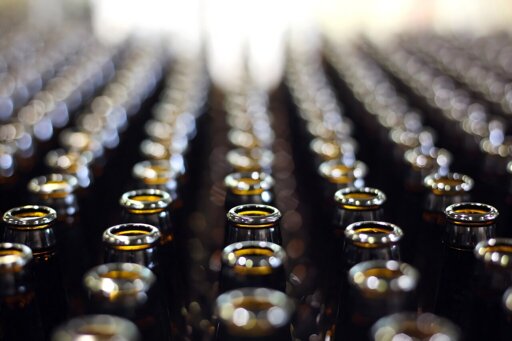- cross-posted to:
- [email protected]
- cross-posted to:
- [email protected]
I’m sorry but I saw this and just busted out laughing because jesus fucking christ :yea:
Mmmmhhnngg… im so… uurrp… full and sloshy from… hng… m-microplastOOUURRRPSSS
Time to return to wax
How. The lid is such a leaker of microplastics that it’s worse than the entire rest of the bottle? Genuinely what the fuck.
Is this the little plastic sealer inside the aluminum bottlecap, or for full plastic lids?
It’s the paint on the lid, when I first read this report it seems like it was specifically metal lids
[turns up music volume until I can’t hear anything anymore]
OK, I guess I’ll just die

Fully buoyant balls by 2030, let’s gooo
“We expected the opposite result,” Ph.D. student Iseline Chaib, who conducted the research, told AFP.
“We then noticed that in the glass, the particles emerging from the samples were the same shape, color and polymer composition—so therefore the same plastic—as the paint on the outside of the caps that seal the glass bottles,” she said.
The paint on the caps also had “tiny scratches, invisible to the naked eye, probably due to friction between the caps when there were stored,” the agency said in a statement.
This could then “release particles onto the surface of the caps,” it added.
OK, so maybe a minor change in how these bottles are filled and sealed could end up fixing the issue. There’s clearly some issues with soft drink assembly lines, and if these can be addressed, then the overall amount of microplastics can be mitigated. Seems like we need to start phasing plastics out of every step of manufacturing if we want to end microplastics in food and drink.
Seems like a decent solution is “Don’t paint the lids”
If the scratches are invisible to the naked eye, then there is nothing that can be done on the manufacturing line, there is going to be too much random variation to fix that. The option would have to be getting rid of any plastic altogether in the design room, which likely would shorten the length of product shelf life to an unacceptable degree for these products.
If this is the same data I saw from another article the researchers showed that cleaning the caps with compressed air before putting them on bottles reduced the plastic by a large margin.
All of these factory spaces have metrology departments for confirming product specifications are in spec, who are likely to have training and expertise in defect isolation (as in finding where a defect is coming from). I have very little doubt that they would be able to create/purchase the necessary tools for checking for microplastic dispersion within the factory floor and isolating the key locations that need fixing. That is, if regulations started requiring and testing for lower microplastic content.
Your cancer is a necessary consequence of branding and marketing
I’m surprised wine is not contaminated.
https://winepairingtips.com/blog/wine-corks-materials/#Synthetic_Corks_An_Alternative_Solution
Retvrn
Does anyone have a long ass video on what this microplastics shit is? Anytime I hear about it I’m like “ok so what?”
I don’t have a video, but from what I understand is they are small plastics (as the name suggests) smaller than 1mm. Larger plastics pass through your digestive system and are excreted, but smaller ones can pass into the body’s internal bloodstream and accumulate in internal organs.
The body cannot cleanse them as they are inert. Scientists are researching their relationship with degradation of bodily functions resulting in infertility, inflammation and other diseases.
This is an issue that will worsen over time as plastic production continues unabated. Because humans are at the top of the food chain, as plastics accumulate in our environment, they will increase in over time in the foods we consume (bioaccumulation, think of plankton absorbing plastics, that are eaten by krill and build up in the crustacean’s body, then the krill is eaten by a minnow and because one minnow eats many krill, the proportion of microplastic increases as you move up the trophic chain. That minnow is eaten by a tuna, that is then eaten by a human. That person human will ingest more microplastics.
This is in addition to the plastic present in water, vegetables and grains through contamination of ground and rain water, which isn’t removed by basic water treatment. Or the plastics that fray from synthetic clothing, especially under friction and heat such as during washing, and are inhaled.
Recycling of plastics is also a complete non-starter because the the plastic degrades in quality with each reuse before it joins the rest of the rubbish in landfill.
At what point the quantity of plastics in the brain, in particular, causes it to totally stop working goodness knows. A recent report says that the average USA adult has a plastic spoon (that’s the spoon itself, not the measurement of the bowl of the spoon)'s worth of plastics in the brain. The longer you can delay this the better. Probably.
My whole thing is, the term “plastic” can refer to a ton of different materials and while most are stable to the point of non-reactivity, most of these materials are essentially organic substances (hydrogen, carbon, oxygen, nitrogen, etc). I never see anyone talk about methods or standard deviations or anything like that it’s just “there’s a spoon in your brain!” Is there? it’s LDPE specifically? Styrene? PVC? what are we talking about?
Mostly polyethylene

I’m not fully convinced that py-GC/MS is great for plastics quantitation but there you go
Oh cool the most basic hydrocarbon chain lol. No I too have doubts on quantifying plastics with GC/MS. I don’t run tests like that but I do work with the results/analytical and unreactive plastic compounds like this are almost never detected with confidence.
The data is good to see though where did you get this?
The data is from this paper - https://www.nature.com/articles/s41591-024-03453-1
Nice! After doing some research it seems the general consensus is that LDIR is better for detecting and distinguishing plastics, but only detects down to a radius of ~5um. In this paper they opted to use py-GC/MS in order to document smaller particles.
The problem with pyrolysis however is that by busting everything up it’s more likely that polyethylene can be confused with other hydrocarbons. In the paper it seems their only confirmation is that the data matches up with other labs that have run the same py-GC/MS tests. The paper also mentioned someone using electron microscopy to see microplastics in brain tissue, describing them as “nanoscale shard-like fragments.” However there’s no source for it and I can’t find it.
I did find this article comparing microplastic detection methods I thought was pretty interesting. A few years old tho.
What. I was literally thinking switching to glass would be better
Good news! Now you can switch again and think its better.
What about cans please i hope they’re fine :(
the internal lining of cans is plastic, definitely not fine in this particular context
Oh. That’s okay I don’t like liquid anyway

I thought that was just coca-cola (and probably other colas) due to the acidity?
I think on the one hand, many many things in cans are acidic. Any sparkling beverages, anything with tomato, anything with added acid as preservative, with citrus, etc.
On the other hand, all the cans have the lining and tend to sit in hot warehouses and trucks and ships for weeks, if not months or even years, before being consumed. I don’t know if every can is releasing as much as a soda, but they all have it and it would be hard to believe that less acidic canned goods are not having leeching
I looked it up and I kept seeing “most cans have plastic linings” but I couldn’t find anything stating what things didn’t so I’m gunna’ assume it’s all of them and maybe it’s just like canned meat or some niche items or something that doesn’t have the plastic lining.
Yeah I’m pretty sure it’s all of them these days but maybe there are some specialty canning spots.
Nope
Well, fuck
return with a V to cork and wax seals


















